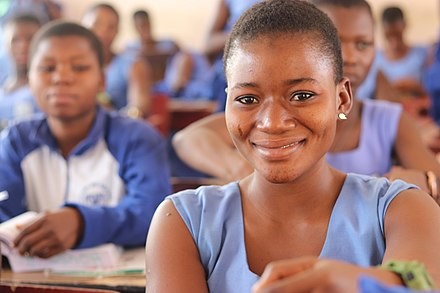Access to education is a basic human right for all. However, due to various socio and traditional reasons, the African girl child has over the years been deprived of this basic right and has been left behind by the male folk.
It is in the quest to bridge this gap across Africa that governments, non-governmental organisations, private bodies, and other relevant agencies have taken up the responsibility of putting more emphasis on getting the girl child educated at all costs.
Have these moves yielded any positive results so far? We will find out in this piece which relays the achievements recorded by African countries in their pursuit of getting the girl child well educated.
The girl child in Africa was in the past plagued with socio and traditional sentiments which left her limited in so many areas of life including education which put her at the mercy of the men folk through lack of education, early marriages, farmwork, and house chores.
However, over the last decades, several efforts have gone into changing this status quo and meeting up with normal standards of life where every child whether boy or girl has an equal right to life and in particular education.
These efforts have led to the relegations of traditional and cultural beliefs and on the other hand, brought about an increase in the number of girls enrolled in schools in Africa.
The various activities and support from local, national, and international bodies have not been in vain as there have been records of improvements in school enrolment by girls across the continent.
Some African countries with appreciable progress in girl child education
While there are still ongoing efforts across the counties on the continent on educating the girl child, some countries are already witnessing rapid improvements and successes of the various programs and initiatives towards this goal.
Listed below are some of the African countries that have recorded appreciable success in the goal of encouraging girl child education on the continent.
Rwanda which has the highest school enrolment rate in East Africa
One such country in Africa is Rwanda which has the highest school enrolment rate in East Africa and has done well for itself in the area of supporting more girls’ enrolment.
According to a UNICEF report, Rwandan girls have surpassed boys in school enrolment at all levels with girls at 98 percent and boys at 97 percent.
The Rwandan government with much determination is working alongside foreign partners and organisations like the World Association of Girls Guides and Girl Scouts whose efforts are seen in terms of funding as well as physical and moral support.
With the new level of focus on girl child education in Rwanda, the girls have come to the realisation that they can explore new and better options beyond the traditional gender roles.
More government-funded schools now specialise in science, technology, engineering, and mathematics (STEM) education and also encourage more girls’ participation.
For instance, the Rwanda Coding Academy admits 50 percent of girls and women and aims to resolve the shortage of engineers through a focused engineering program at the high school level for girls.
Malawi’s success story
Elsewhere in Malawi, it is another success story as combined efforts from both local and international bodies have helped reduce the impact of early marriage and pregnancy which contributes to high dropout rates of girls in the country.
Through the activities of different international agencies taking up specific roles in areas of feeding, provision of infrastructure, and health amenities and the like as well as the communities and parents saddled with the responsibility of continuous monitoring and guidance, the country is doing well in increasing the number of girls in schools.
With such a programme as the Joint Programme on Girls’ Education implemented by UN agencies and funded by the Government of Norway, girls’ enrolments in schools in Malawi have increased tremendously while the school drop-out rate dropped.
There is also AGE Africa’s programme for girls in the country which offers scholarship programmes to support the girl child’s education by providing uniforms, educational materials, etc to beat the scourge of poverty which hinders their enrolment in school.
It has also recorded success with its social programme tagged Creating Healthy Approaches to Success (CHATS). The two-year programme which is an after-school life-skills program target giving scholars tools to overcome social barriers like poverty, early marriages, and the like which affect girls’ education.
CHATS has made visible impacts because, through its efforts in selected areas of the country, 90% of participants complete secondary school, and 91% delay marriage and pregnancy until after their 18th birthday with renewed hopes for a better future.
In Zambia, the future looks bright for girls
For girls in Zambia, the future looks bright, especially with the government initiative of “Zambian Girls 2030 Programme: Realising my Potential” which provides an opportunity for the most vulnerable girl pupils to be exposed and inspired into a chosen career path.
Before now, many girls in Zambia have their dreams stifled by several social and economic factors including poverty and a prevalence of Gender Based Violence (GBV) in their communities but through the initiative, a triad of heads of schools, parents and community leaders have been successfully created who work as a team to ensure that girls go to school and do not drop out.
Funded by the Governments of Sweden and Ireland, the project not only encourages school enrolment for girls but also specifically partners with national institutions such as the Zambian National STEM Foundation and the Zambia Information and Communications Technology Authority (ZICTA) to encourage young women and girls to pursue a career in Science, Technology, Engineering and Mathematics (STEM).
The Zambian government has also instituted a national response to address child marriage which is the major root cause of girls dropping out of school by launching a multi-stakeholder anti-child-marriage campaign which seeks to lower the rate to building ” a Zambia free from child marriage by 2030″.
The programme has put in place structures to fight child marriage effectively including a civil society coalition against child marriage.
As a result of these initiatives, girls in Zambia now have access to break into the earlier male-dominated STEM programmes, create their own space and even encourage others along that line.
With all hands-on deck and continuous initiation of relevant programmes, all countries on the continent will get it right with the girl child to give them room to make meaningful impacts on their societies because educating the girl child goes beyond just education, rather, it comes as an empowerment mode to break the cycle of poverty and in turn affect the economy positively.


